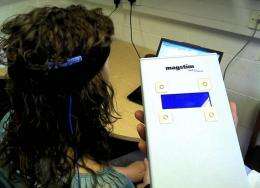Tiny electric currents may aid stroke recovery

(Medical Xpress) -- Tiny electric currents applied across regions of the brain can improve hand movements in recovering stroke patients for a short period, an Oxford University study has demonstrated.
The researchers are hopeful that developing this brain stimulation technique may provide a useful addition to standard physiotherapy in helping the recovery of stroke patients.
The study involving 13 patients was able to observe a significant 5–10% improvement in patients’ response times in making hand movements.
The effect for this single treatment lasted for an hour or so. But neuroscience studies in other research areas have shown effects lasting months after daily application of this form of brain stimulation.
The study, funded by the NIHR Oxford Biomedical Research Center, the Dunhill Medical Trust and the Wellcome Trust, is published in the journal Brain.
"The improvements in movement and reaction times were significant," says lead researcher Dr. Charlotte Stagg of the Oxford Center for Functional Magnetic Resonance Imaging of the Brain (FMRIB) at Oxford University. "Patients certainly noticed them, but they were short-lived. However, we are very hopeful that daily brain stimulation would lead to longer-lasting improvements.
Much larger clinical studies would be needed to show that brain stimulation had a lasting effect in producing clinical benefits for stroke patients, for example in greater recovery of movement and ability to carry out all the activities of daily life.
The Oxford team, for the next stage of their research, are currently recruiting around 30 stroke patients to a trial that will look at whether daily brain stimulation in addition to physiotherapy exercises can lead to tangible benefits after a period of three months.
"This was a study in a small group. Large-scale trials would be needed before concluding that the approach benefits those recovering from strokes," says Dr. Stagg. But she notes that: "The brain stimulation technique is relatively cheap, easy to use and it’s portable. You could imagine physiotherapists using it in their practice in the future."
The damage caused by a stroke can be widespread and long-lasting, often involving weakness or loss of movement in one side of the body. Many people will need a significant period of rehabilitation and physiotherapy to recover. The amount of movement and independence people are able to regain is very variable, so developing extra therapies to aid recovery would be of great importance.
The Oxford University researchers headed by Professor Heidi Johansen-Berg, along with colleagues at the Oxford Centre for Enablement at the Nuffield Orthopaedic Centre, set out to investigate whether a brain stimulation technique designed to increase the activity in the motor cortex would improve hand movements in people who’d had a stroke.
The brain stimulation technique, called transcranial direct current stimulation or TDCS, involves passing a small electrical current of about 1 milliamp across part of the brain using simple pads placed on the outside of the head. It’s a relatively new technique but is known to increase the ‘excitability’ of neurons in the targeted region of the brain. It has been shown to be safe in many studies: if anything, people may feel a slightly tingly or itchy sensation on their scalp.
The study included a wide range of patients who’d had a stroke at least six months previously – aged from 30 to 80, both sexes, and different types of stroke.
The patients carried out a simple task involving a hand movement in response to images on a computer screen three times – before, during and after brain stimulation using the electric current for 20 minutes.
The 5–10% improvement in reaction times was observed during and after the short time of applying the current. The improvement was not seen in dummy treatments when no current was applied. Nor was it seen when the current was applied in the opposite direction, which would tend to reduce brain activity in the stroke-affected region.
"The improvement was almost immediate. It really did work, says Dr. Stagg.
"The approach seems to have an effect in a wide range of stroke patients. Those who had seen least recovery from their stroke seemed to show most improvement in this simple test," she adds.
The study participants also completed similar tasks in an MRI scanner to detect whether there were any changes in brain activity.
After the brain stimulation with the electric current, there was increased activity in brain regions associated with movement in the stroke-affected side of the body.
"The amount that brain activity increased, as seen in the fMRI scans, appeared to be linked to the level of improvement seen in people’s reaction times," explains Dr. Stagg.

















